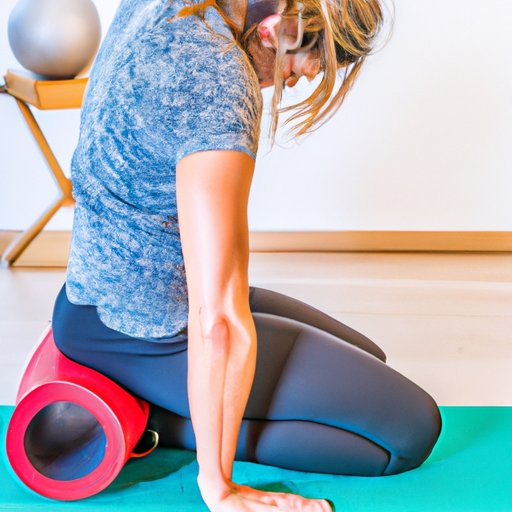Introduction
Have you ever felt the urge to crack your lower back to relieve the tension? You are not alone. Cracking your lower back has been a common practice for many people to alleviate pain and stiffness. However, it’s essential to do it safely and correctly. This article is for anyone who wants to learn how to crack their lower back effectively. Here’s a breakdown of what you will learn:
Stretching Exercises
Stretching is an excellent way to prepare your lower back for cracking. It improves flexibility, increases blood flow, and reduces the risk of injury. Here are three stretching exercises you can do at home:
Knee-to-chest stretch
1. Lie on your back with your legs stretched out.
2. Bend your right knee and hug it towards your chest.
3. Hold for 20-30 seconds.
4. Release and repeat on the other side.
Seated spinal twist
1. Sit on the floor with your legs extended in front of you.
2. Bend your right knee and place the foot on the outside of your left knee.
3. Twist your body to the right and place your left elbow on your right knee.
4. Hold for 20-30 seconds.
5. Release and repeat on the other side.
Child’s pose
1. Start on your hands and knees.
2. Keep your arms extended as you push your hips back towards your heels.
3. Stretch your arms out in front of you as you relax your head and neck.
4. Hold for 20-30 seconds.
Remember to breathe deeply and slowly during each stretch and stop if you experience any pain or discomfort.
Foam Rolling
Foam rolling is another effective technique to relieve tension in your lower back. It helps to massage and stretch the muscles, reducing tightness and improving mobility. Here’s how to do it:
Basic foam rolling technique
1. Lie on your back with a foam roller under your shoulder blades.
2. Bend your knees and place your feet flat on the ground.
3. Lift your hips off the ground and roll the foam roller up and down your spine.
4. Target any areas that feel tight or sore.
5. Roll for 1-2 minutes.
It’s essential to start with a soft foam roller and gradually work your way up to a firmer one. Also, avoid rolling directly on your lower back’s spine to prevent injury or discomfort.
Chiropractic Adjustments
Chiropractic adjustments are effective for relieving lower back pain by restoring your spine’s natural alignment and promoting healing. However, it’s crucial to have it done by a licensed chiropractor to avoid any risks. Here’s what you need to know:
A chiropractic adjustment involves a quick thrust to a specific joint to restore its mobility. During the procedure, you may hear a popping sound, which is gas being released from the joint. While the adjustment itself is generally painless, you may experience soreness or discomfort afterwards. It’s essential to take it easy and avoid heavy lifting or strenuous activities for at least 24 hours after the treatment.
Yoga and Pilates
Yoga and Pilates are two low-impact exercises that can benefit people with lower back pain. They promote flexibility, core strength, and balance, which can help relieve tension in the lower back. Here are some recommended poses:
Downward dog
1. Start on your hands and knees.
2. Straighten your arms and lift your hips up towards the ceiling.
3. Push your chest towards your thighs as you lengthen your spine.
4. Hold for 20-30 seconds.
Pilates spine stretch forward
1. Sit on the floor with your legs extended in front of you.
2. Reach your arms forward and round your spine.
3. Hold for 5-10 seconds.
4. Roll back up to a seated position.
Remember to listen to your body and stop if you experience any pain or discomfort during these exercises.
Massage Therapy
Massage therapy is a non-invasive treatment that can help relieve tension and pain in the lower back. It involves manipulating the muscles and soft tissues to promote relaxation and healing. Here are some common massage techniques:
Swedish massage
1. Apply long, flowing strokes to the muscles.
2. Use a light to medium pressure.
3. Target any areas that feel tight or sore.
4. Massage for 30-60 minutes.
Deep tissue massage
1. Apply deep pressure to the muscles using fingertips, knuckles, or elbows.
2. Target deeper layers of muscles and connective tissues.
3. Massage for 30-60 minutes.
Remember to communicate with your massage therapist about your needs and preferences. Also, drink plenty of water after your massage to help flush out any toxins from your body.
Lifestyle Changes
Preventing lower back pain involves making some lifestyle changes. Here are some recommendations:
Proper posture
1. Stand up straight with your shoulders back.
2. Keep your weight evenly distributed on both feet.
3. Avoid slouching or leaning to one side.
Regular Exercise
1. Engage in low-impact exercises like walking, swimming, or biking.
2. Build up strength and flexibility in the back muscles.
3. Avoid high-impact activities that strain the lower back.
Healthy Diet
1. Maintain a healthy weight to avoid putting excess strain on your lower back.
2. Eat a diet rich in fruits, vegetables, and lean protein.
3. Avoid processed foods and sugary drinks that can cause inflammation.
Remember to incorporate these changes gradually into your daily life to make them sustainable.
Conclusion
In conclusion, cracking your lower back can provide relief from pain and stiffness, but it’s essential to do it safely and correctly. Stretching exercises, foam rolling, chiropractic adjustments, yoga and Pilates, massage therapy, and lifestyle changes are all effective ways to prevent and alleviate lower back pain. Remember to listen to your body and seek medical advice if you experience severe or chronic pain.
